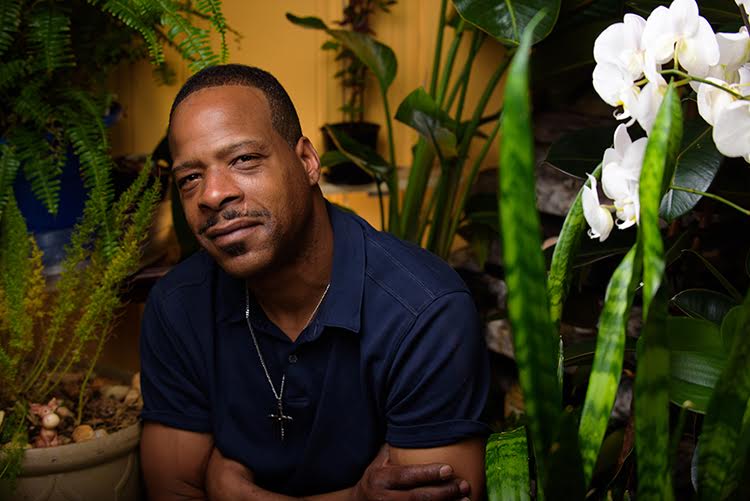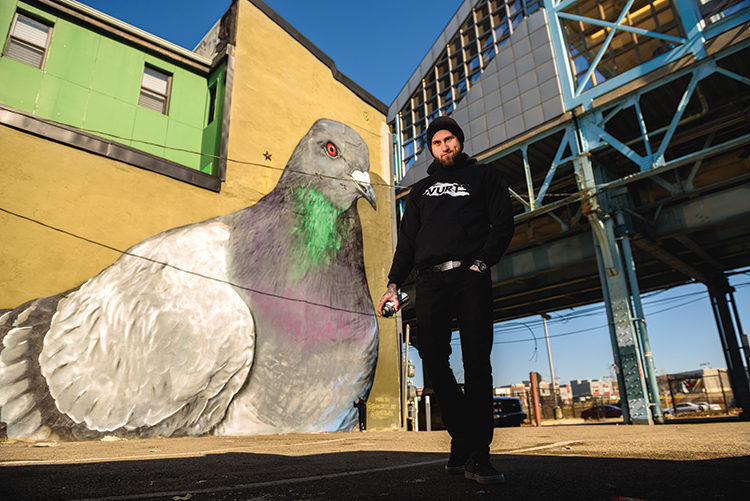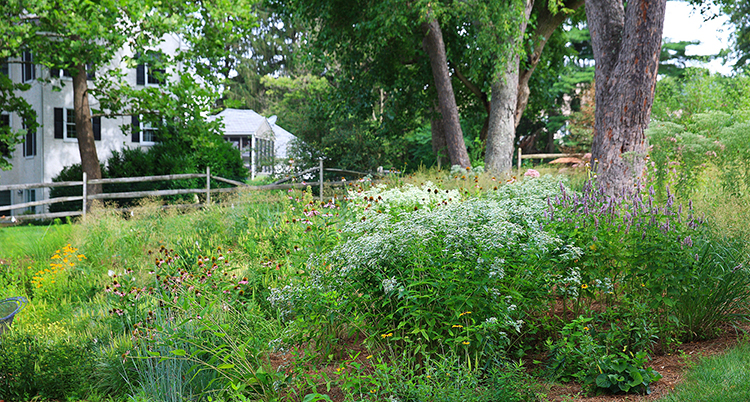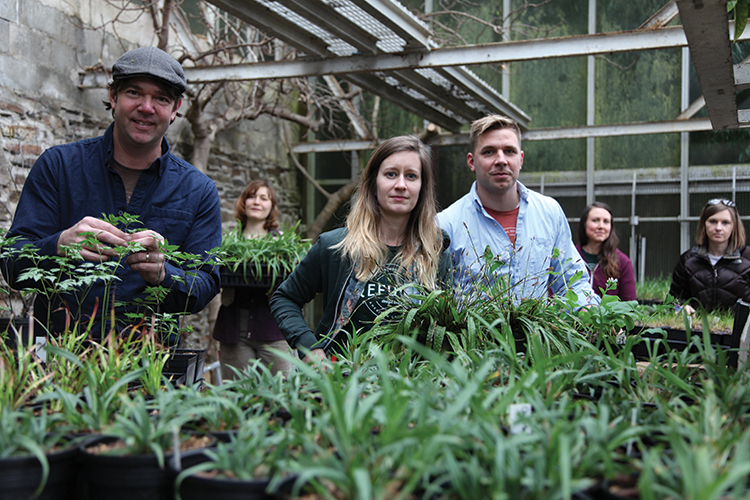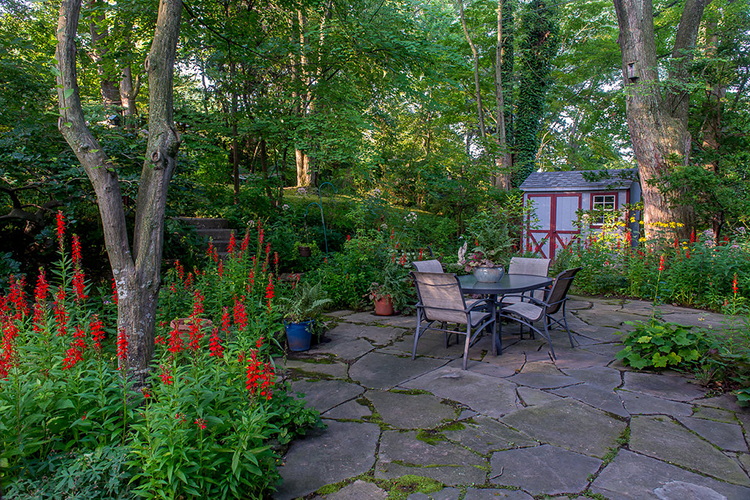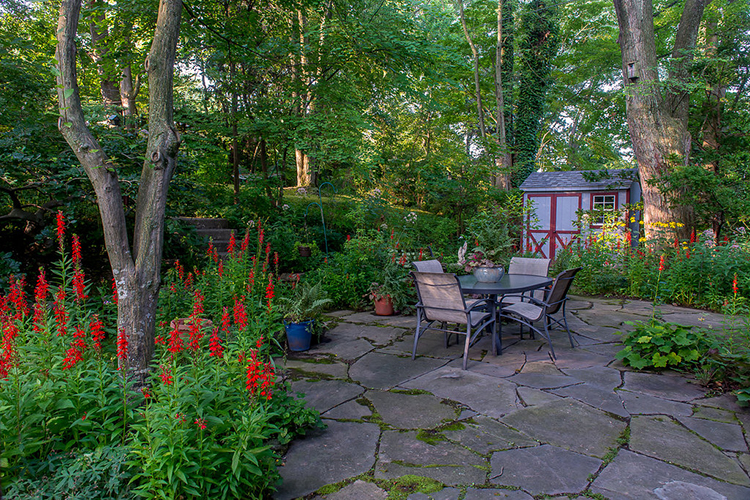By Alex Jones
Nakia Maples, better known as Philly Plant Guy, has around 200 plants in his South Philly rowhouse. They’re mostly tropicals like palms, philodendrons and long, trailing pothos in hanging baskets. In his “plant room”—where the only unoccupied space is a small sofa—a fountain gurgles away, and humidity-loving ferns hang above. A turtle swims in a fish tank in one corner; on the other side of the room, carnivorous plants like pitchers and sundews stay steamy and moist in glass fish tanks. Visitors—who may contact Maples through social media and request a quiet session in the plant room when they need some chillout time—are asked to sign the guest book.
Maples works as a stagehand, setting up and breaking down shows at the Pennsylvania Convention Center (including this month’s Philadelphia Flower Show, which is always a boon to his collection). His first plant was a simple pothos and is still one of his favorites. But once he was hooked, he went straight to carnivorous plants, some of the most challenging to raise in this climate.
“For me, it’s a lifestyle,” Maples said. “I say this because a hobby is something you can pick up and put down. Plants are something that I have to physically integrate into my everyday life.” When he’s sipping coffee in the morning, Maples mists his plants—and typically posts a morning greeting to the 900-plus members of the Philly Plant Guy Facebook group.
“It’s more like having a pet,” he says—and that includes the regular costs of upkeep, just like a furry friend would. Instead of food, litter, dog park dues and vet visits, his expenses are fertilizer, neem oil to keep gnats and other bugs at bay, replacement soil and containers, and the occasional new member of the family he’s purchased, rather than propagated himself or swapped from another plant lover.
This is the life Maples has wanted—green everywhere, humidifiers chugging away, plantlets rooting in water—since he was a teenager, when he saw the apartment of a friend whose mother was into plants. “I remember the first time that I walked into her apartment, and she had a plant apartment,” he remembers. “I decided that that’s the way that I wanted to live. It was something deep inside me.”
And who wouldn’t want to live in a lush, green, indoor environment? With our lives busier than ever, people spend much of their time tethered to a desk and a computer screen. As much as we might want to, we can’t always get out of the city for that woodland walk or waterfall hike. Surrounding ourselves with greenery mirrors the natural environment in which humans in many parts of the world evolved over hundreds of thousands of years. When we can’t head for the forest for reinvigoration and clarity, a potted version in our living space can provide a temporary soother.
That explains why, according to the National Gardening Survey, consumers are purchasing more indoor plants. And guess who’s driving that growth (pun very much intended)? Millennials, who apparently love plants almost as much as they love their phones.
Survey results indicate that American gardeners grew by 6 million in 2016, with 5 million of those with newly minted green thumbs coming from the 18-to-34 age demographic.
You only need to look at Instagram—where @cactusmagazine reposts the cutest succulent shots to its 200,000 followers, and more than a million photos are tagged #plantsofinstagram. The Washington Post can tell you, too: “Millennials are filling their homes—and the void in their hearts—with houseplants,” read a headline last fall, pointing out the idealized way that the social media platform seems to present the trend toward indoor gardening.
But social media serves another vital purpose. It’s increasingly becoming the way that people find, learn about and troubleshoot houseplants. They’re also connecting with each other, meeting up in real life for one-on-one plant trades and swap events, or just commiserating online about their leafy relationships. It’s sort of like a community garden, only indoors and in front of a screen.
Take Philly Plant Exchange, a bustling Facebook group with more than 3,800 members. Aside from regular plant identification questions from new plant owners, within the group there are pest questions, care questions, posters seeking specific species or cultivars in the area—and, sometimes, celebration. When an ailing plant has been nursed back to health, a sought-after specimen gets added to a collection, or a typically reserved houseplant blooms for the first time, members can snap a photo and share the good news.
For many, though, love for indoor plants predates the social media phenomenon.
Alanna Bozman works as an indoor and outdoor gardener for private clients, including one with a couple hundred houseplants that need regular love and tending in the winter. Over a decade or so, Bozman has amassed her own collection of around 150 plants in her West Philly apartment. With lots of trees and tropicals in her collection, many are sizeable, over 6 feet tall.
In the summer, she gets a few friends to help out and drags most of her collection across the street to the community garden, of which she’s a member, so that they can get the full benefit of long days and warm weather. Come autumn, they go back inside—a much longer process, since she has to find the right space to store each one—with many, including a lush, floaty fiddle-leaf fig, a spreading split-leaf philodendron, a lime tree, several plumeria trees and birds-of-paradise that she started from seed, occupying her verdant, jungle-like “plant studio.”
“In the winter, it really lifts my spirits, and the spirits of my friends,” she said of her collection. We’re seated inside, beneath the studio’s greenery, and I can’t stop looking up—almost as though I’m in a forest. “It reminds us of the coming summer, and it cleans the air inside. It helps me to have so many little things to care for. And it’s just nice to look at.”
Peicha Chang has also seen the power that a green indoor space can have on people. Chang opened Falls Flowers in East Falls seven years ago; last year, her business relaunched in a larger space as Vault + Vine, offering not just bouquets and floral design for events, but also an extensive slate of indoor plants, gifts and a café that includes a seating area inside a greenhouse that stays balmy in the most frigid winter temperatures.
“I don’t think you can ever really live in a green enough environment,” Chang said. “There’s something about plants that lets you slow down when you’re near them and realize how important the natural world is.”
Erin Doherty, a former plant collector turned plant seller, sees the effect that plants have on people every day. When she was laid off from her corporate job, a friend suggested she sell her plant collection, which included many hard-to-find cacti and succulents from business trips to California. She was aghast at the prospect, but the idea of selling plants stuck with her. She started with pop-up plant sales around Fishtown, then landed a permanent spot for her store, Field, on Frankford Avenue last summer.
“People walk into the store and their faces light up,” she said. “They see things that are alive and healthy. I don’t want to go as far as to say that plants give people hope, but it’s a breath of fresh air.”
Doherty counsels her customers—who often overload with wonder when they enter her verdant shop—with a consultation that is part therapy, part practical advice. Buying choices depend on a customer’s lighting situation and other aspects of their home environment, sure. But, Doherty says, the question is how much you want to commit—of time, of money, of yourself—to a small or large plant family.
“I get both ends of the spectrum,” Doherty said. “Start small, because you
don’t want to invest a ton of money in something you’re unsure of. Or start huge, because the more you invest, the more likely you’ll be to take care of it.”
And while some are more casual plant parents, others take their responsibilities rather seriously.
Xue Davis, a postdoctoral fellow in neuroscience at the University of Pennsylvania, moved to Philly in 2015 and joined Facebook group last year. Someone gave her dozens of aloe plants, so she set about giving them away to fellow members. “It’s been so, so amazing,” Davis said. “I’ve met a lot of really cool people through the group, including some people who all work within a square block of me, so we will all meet up at my lab and each bring swaps for each other.”
She estimates that among her home, her office and her husband’s house, she has around 110 plants—mostly tiny succulents like echeveria, which are her favorite.
But Davis’ collection is dwarfed by that of Alison Friedlander, another Philly Plant Exchange member. The Manayunk resident estimates that she has had more than 500 succulents in her collection—fewer now that a DIY greenhouse she built on the back of her house was damaged during January’s extreme cold snap. She started with two cacti, purchased on a whim during a trip to Home Depot. A month later, she had 40 plants, “because I have no self-control,” she joked.
That was two years ago. Now, her basement is home to hundreds of colorful cacti and succulents, kept under the grow lights they need to stay healthy out of their desert habitat (and away from her curious cats). “I usually go down once a day for a few minutes to look at them, because they’re pretty,” she said. A large plant collection also tends to come with pests, so Friedlander spritzes any mealy bugs she finds on her specimens with a rubbing alcohol solution to keep them at bay.
Friedlander admits that she has a tendency to go all in on interests—her collection of succulents begat an air plant habit, and once she built a habitat for the air plants, she realized she could raise poison dart frogs in the same environment. There’s a chance she’ll sell a portion of her collection on Etsy in the future; for now, though, her collection gives her too much joy to ever really give up.
But even the most experienced plant lovers need a little help sometimes. When drooping leaves and pest damage become too much for an amateur to handle, sometimes you have to call in the experts.
Martha O’Neill is a professional gardener and farmer whose résumé includes stints at City Planter in Northern Liberties, Tooth of the Lion herb farm in Berks County and plantings for private clients. Last year, she started offering support to troubled Philly plant parents through a project called Housecalls for Houseplants.
Call O’Neill to gently diagnose what’s ailing your babies (no plant shaming allowed), be it an insect infestation, too much or too little water or light, the wrong-sized pot or poor placement in your living space. When she’s done, you’ll have care tips and tricks and a watering plan to set your babies on the right track.
When a houseplant is showing signs of distress, like a few dead or drooping leaves, O’Neill says that doesn’t mean you should give up on it.
“Believe in the resilience of your plants,” she advises. “Remember, your plant is a living organism.” If you intervene early enough and give your plant what it needs, it can usually bounce back. “It’s also really important to place your plants somewhere where you will see them every day. Putting them in your way helps you remember that they need care.”
O’Neill charges for her services—which require a site visit—but the relationship people have with their houseplants, sometimes through generations, makes the money worth it. There’s something more to that relationship between plant and human, O’Neill says, than, say, tending your yard and leaving it behind when you move to a new home.
“The difference with houseplants is you can carry them with you everywhere,” she says. “This is why you can have a Christmas cactus or a sago palm that your grandmother had for 25 years before you—and with that comes a lot of sentimentality.
“These plants are family heirlooms, longtime friends,” O’Neill says, “and by nurturing them, we enrich our own lives.”
Well, when you put it that way, our current houseplant trend is pretty easy to understand after all.


